Ernie Chang
Shammie
Self-Vocabularizing Training for Neural Machine Translation
Mar 19, 2025Abstract:Past vocabulary learning techniques identify relevant vocabulary before training, relying on statistical and entropy-based assumptions that largely neglect the role of model training. Empirically, we observe that trained translation models are induced to use a byte-pair encoding (BPE) vocabulary subset distinct from the original BPE vocabulary, leading to performance improvements when retrained with the induced vocabulary. In this paper, we analyze this discrepancy in neural machine translation by examining vocabulary and entropy shifts during self-training--where each iteration generates a labeled dataset by pairing source sentences with the model's predictions to define a new vocabulary. Building on these insights, we propose self-vocabularizing training, an iterative method that self-selects a smaller, more optimal vocabulary, yielding up to a 1.49 BLEU improvement. Moreover, we find that deeper model architectures lead to both an increase in unique token usage and a 6-8% reduction in vocabulary size.
Agent-as-a-Judge: Evaluate Agents with Agents
Oct 14, 2024



Abstract:Contemporary evaluation techniques are inadequate for agentic systems. These approaches either focus exclusively on final outcomes -- ignoring the step-by-step nature of agentic systems, or require excessive manual labour. To address this, we introduce the Agent-as-a-Judge framework, wherein agentic systems are used to evaluate agentic systems. This is an organic extension of the LLM-as-a-Judge framework, incorporating agentic features that enable intermediate feedback for the entire task-solving process. We apply the Agent-as-a-Judge to the task of code generation. To overcome issues with existing benchmarks and provide a proof-of-concept testbed for Agent-as-a-Judge, we present DevAI, a new benchmark of 55 realistic automated AI development tasks. It includes rich manual annotations, like a total of 365 hierarchical user requirements. We benchmark three of the popular agentic systems using Agent-as-a-Judge and find it dramatically outperforms LLM-as-a-Judge and is as reliable as our human evaluation baseline. Altogether, we believe that Agent-as-a-Judge marks a concrete step forward for modern agentic systems -- by providing rich and reliable reward signals necessary for dynamic and scalable self-improvement.
Scaling Parameter-Constrained Language Models with Quality Data
Oct 04, 2024



Abstract:Scaling laws in language modeling traditionally quantify training loss as a function of dataset size and model parameters, providing compute-optimal estimates but often neglecting the impact of data quality on model generalization. In this paper, we extend the conventional understanding of scaling law by offering a microscopic view of data quality within the original formulation -- effective training tokens -- which we posit to be a critical determinant of performance for parameter-constrained language models. Specifically, we formulate the proposed term of effective training tokens to be a combination of two readily-computed indicators of text: (i) text diversity and (ii) syntheticity as measured by a teacher model. We pretrained over $200$ models of 25M to 1.5B parameters on a diverse set of sampled, synthetic data, and estimated the constants that relate text quality, model size, training tokens, and eight reasoning task accuracy scores. We demonstrated the estimated constants yield +0.83 Pearson correlation with true accuracies, and analyzed it in scenarios involving widely-used data techniques such as data sampling and synthesis which aim to improve data quality.
High Fidelity Text-Guided Music Generation and Editing via Single-Stage Flow Matching
Jul 04, 2024



Abstract:We introduce a simple and efficient text-controllable high-fidelity music generation and editing model. It operates on sequences of continuous latent representations from a low frame rate 48 kHz stereo variational auto encoder codec that eliminates the information loss drawback of discrete representations. Based on a diffusion transformer architecture trained on a flow-matching objective the model can generate and edit diverse high quality stereo samples of variable duration, with simple text descriptions. We also explore a new regularized latent inversion method for zero-shot test-time text-guided editing and demonstrate its superior performance over naive denoising diffusion implicit model (DDIM) inversion for variety of music editing prompts. Evaluations are conducted on both objective and subjective metrics and demonstrate that the proposed model is not only competitive to the evaluated baselines on a standard text-to-music benchmark - quality and efficiency-wise - but also outperforms previous state of the art for music editing when combined with our proposed latent inversion. Samples are available at https://melodyflow.github.io.
Basis Selection: Low-Rank Decomposition of Pretrained Large Language Models for Target Applications
May 24, 2024Abstract:Large language models (LLMs) significantly enhance the performance of various applications, but they are computationally intensive and energy-demanding. This makes it challenging to deploy them on devices with limited resources, such as personal computers and mobile/wearable devices, and results in substantial inference costs in resource-rich environments like cloud servers. To extend the use of LLMs, we introduce a low-rank decomposition approach to effectively compress these models, tailored to the requirements of specific applications. We observe that LLMs pretrained on general datasets contain many redundant components not needed for particular applications. Our method focuses on identifying and removing these redundant parts, retaining only the necessary elements for the target applications. Specifically, we represent the weight matrices of LLMs as a linear combination of base components. We then prune the irrelevant bases and enhance the model with new bases beneficial for specific applications. Deep compression results on the Llama 2-7b and -13B models, conducted on target applications including mathematical reasoning and code generation, show that our method significantly reduces model size while maintaining comparable accuracy to state-of-the-art low-rank compression techniques.
MobileLLM: Optimizing Sub-billion Parameter Language Models for On-Device Use Cases
Feb 22, 2024Abstract:This paper addresses the growing need for efficient large language models (LLMs) on mobile devices, driven by increasing cloud costs and latency concerns. We focus on designing top-quality LLMs with fewer than a billion parameters, a practical choice for mobile deployment. Contrary to prevailing belief emphasizing the pivotal role of data and parameter quantity in determining model quality, our investigation underscores the significance of model architecture for sub-billion scale LLMs. Leveraging deep and thin architectures, coupled with embedding sharing and grouped-query attention mechanisms, we establish a strong baseline network denoted as MobileLLM, which attains a remarkable 2.7%/4.3% accuracy boost over preceding 125M/350M state-of-the-art models. Additionally, we propose an immediate block-wise weight sharing approach with no increase in model size and only marginal latency overhead. The resultant models, denoted as MobileLLM-LS, demonstrate a further accuracy enhancement of 0.7%/0.8% than MobileLLM 125M/350M. Moreover, MobileLLM model family shows significant improvements compared to previous sub-billion models on chat benchmarks, and demonstrates close correctness to LLaMA-v2 7B in API calling tasks, highlighting the capability of small models for common on-device use cases.
Not All Weights Are Created Equal: Enhancing Energy Efficiency in On-Device Streaming Speech Recognition
Feb 20, 2024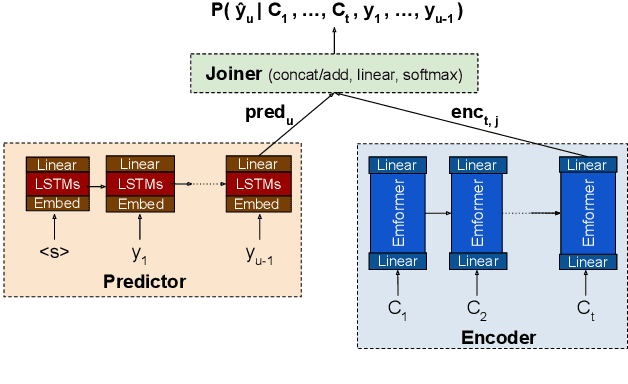

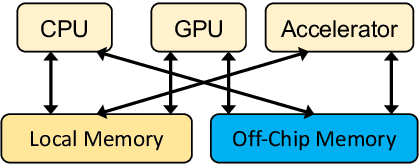

Abstract:Power consumption plays an important role in on-device streaming speech recognition, as it has a direct impact on the user experience. This study delves into how weight parameters in speech recognition models influence the overall power consumption of these models. We discovered that the impact of weight parameters on power consumption varies, influenced by factors including how often they are invoked and their placement in memory. Armed with this insight, we developed design guidelines aimed at optimizing on-device speech recognition models. These guidelines focus on minimizing power use without substantially affecting accuracy. Our method, which employs targeted compression based on the varying sensitivities of weight parameters, demonstrates superior performance compared to state-of-the-art compression methods. It achieves a reduction in energy usage of up to 47% while maintaining similar model accuracy and improving the real-time factor.
On The Open Prompt Challenge In Conditional Audio Generation
Nov 01, 2023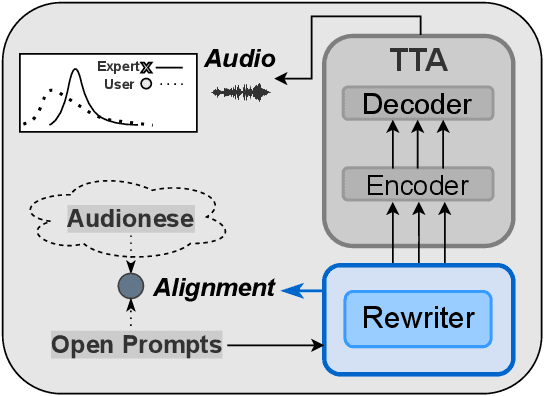
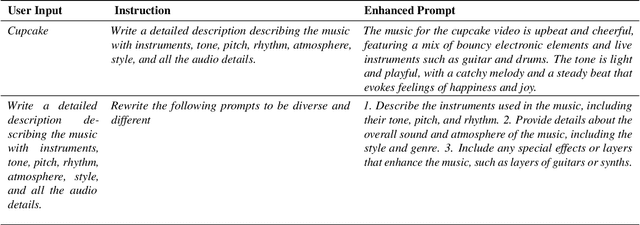
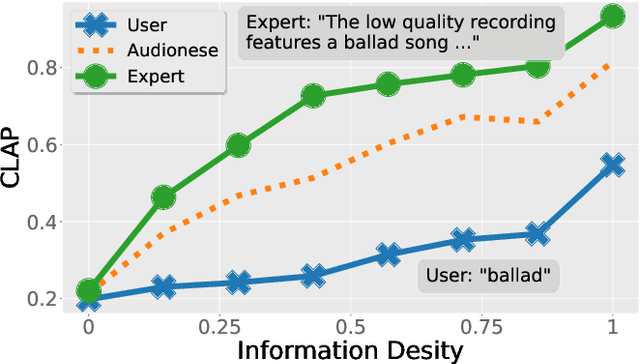

Abstract:Text-to-audio generation (TTA) produces audio from a text description, learning from pairs of audio samples and hand-annotated text. However, commercializing audio generation is challenging as user-input prompts are often under-specified when compared to text descriptions used to train TTA models. In this work, we treat TTA models as a ``blackbox'' and address the user prompt challenge with two key insights: (1) User prompts are generally under-specified, leading to a large alignment gap between user prompts and training prompts. (2) There is a distribution of audio descriptions for which TTA models are better at generating higher quality audio, which we refer to as ``audionese''. To this end, we rewrite prompts with instruction-tuned models and propose utilizing text-audio alignment as feedback signals via margin ranking learning for audio improvements. On both objective and subjective human evaluations, we observed marked improvements in both text-audio alignment and music audio quality.
In-Context Prompt Editing For Conditional Audio Generation
Nov 01, 2023Abstract:Distributional shift is a central challenge in the deployment of machine learning models as they can be ill-equipped for real-world data. This is particularly evident in text-to-audio generation where the encoded representations are easily undermined by unseen prompts, which leads to the degradation of generated audio -- the limited set of the text-audio pairs remains inadequate for conditional audio generation in the wild as user prompts are under-specified. In particular, we observe a consistent audio quality degradation in generated audio samples with user prompts, as opposed to training set prompts. To this end, we present a retrieval-based in-context prompt editing framework that leverages the training captions as demonstrative exemplars to revisit the user prompts. We show that the framework enhanced the audio quality across the set of collected user prompts, which were edited with reference to the training captions as exemplars.
Folding Attention: Memory and Power Optimization for On-Device Transformer-based Streaming Speech Recognition
Sep 21, 2023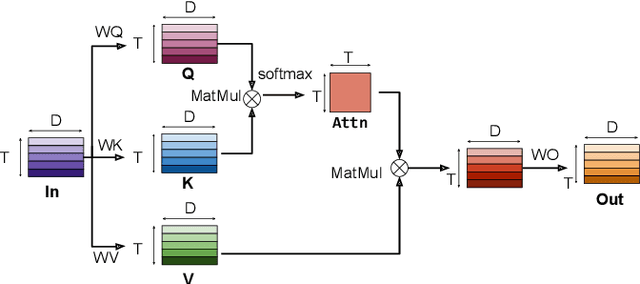

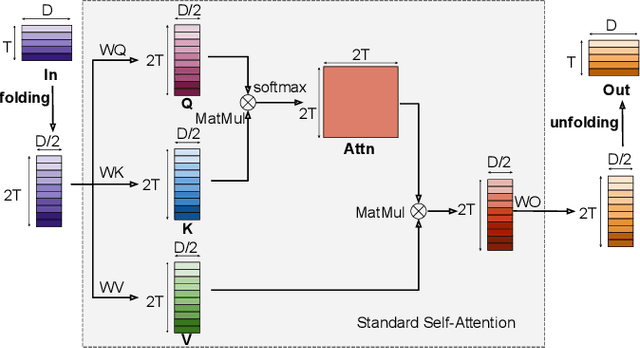
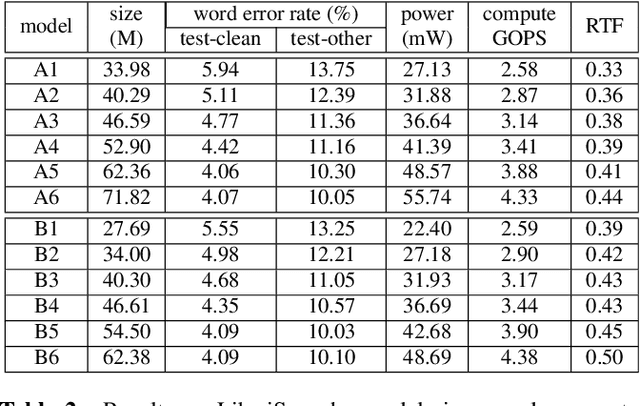
Abstract:Transformer-based models excel in speech recognition. Existing efforts to optimize Transformer inference, typically for long-context applications, center on simplifying attention score calculations. However, streaming speech recognition models usually process a limited number of tokens each time, making attention score calculation less of a bottleneck. Instead, the bottleneck lies in the linear projection layers of multi-head attention and feedforward networks, constituting a substantial portion of the model size and contributing significantly to computation, memory, and power usage. To address this bottleneck, we propose folding attention, a technique targeting these linear layers, significantly reducing model size and improving memory and power efficiency. Experiments on on-device Transformer-based streaming speech recognition models show that folding attention reduces model size (and corresponding memory consumption) by up to 24% and power consumption by up to 23%, all without compromising model accuracy or computation overhead.
 Add to Chrome
Add to Chrome Add to Firefox
Add to Firefox Add to Edge
Add to Edge